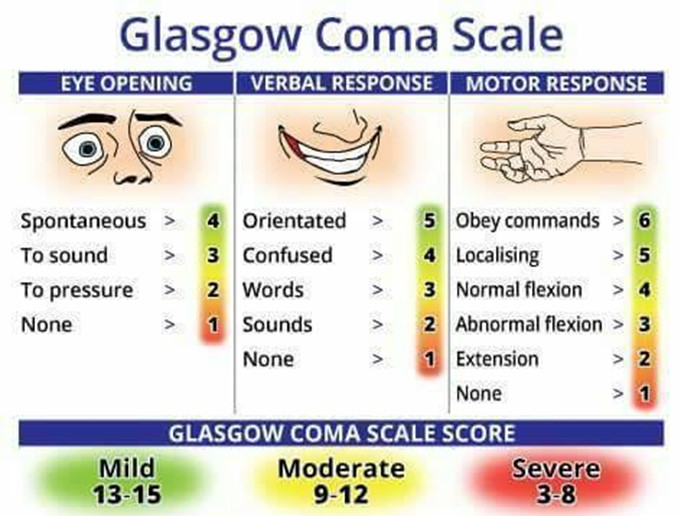A client arrives to the emergency department after losing consciousness during a soccer game. Which of the following actions should the nurse take first?
Prepare the client for an X-Ray.
Calculate a Glasgow Coma Score.
Dim the lights and turn off the TV.
Provide analgesics.
The Correct Answer is B
Choice A reason: This is incorrect because preparing the client for an X-ray is not the first action that the nurse should take. An X-ray can help diagnose possible injuries or fractures, but it is not an urgent test. The nurse should first assess the client's level of consciousness and neurological status using a standardized tool such as the Glasgow Coma Scale.
Choice B reason: This is the correct answer because calculating a Glasgow Coma Score is the first action that the nurse should take. The Glasgow Coma Scale is a tool that measures the level of consciousness based on the eye-opening, verbal response, and motor responses. It can help determine the severity of brain injury and guide further interventions.
Choice C reason: This is incorrect because dimming the lights and turning off the TV are not the first actions that the nurse should take. These are environmental modifications that can help reduce sensory stimulation and prevent agitation or seizures, but they are not as important as assessing the level of consciousness and neurological status.
Choice D reason: This is incorrect because providing analgesics is not the first action that the nurse should take. Analgesics can help relieve pain and discomfort, but they can also alter the level of consciousness and mask neurological signs. The nurse should first assess the level of consciousness and neurological status, and then administer analgesics as prescribed.

Nursing Test Bank
Naxlex Comprehensive Predictor Exams
Related Questions
Correct Answer is B
Explanation
Choice A Reason: Antibiotics are not contraindicated for a client with glaucoma and asthma, as they can treat or prevent infections that may affect the eye or the respiratory system.
Choice B Reason: This is the correct answer because non-selective beta blockers are contraindicated for a client with glaucoma and asthma, as they can reduce intraocular pressure but also cause bronchoconstriction and exacerbate asthma symptoms.
Choice C Reason: NSAIDs are not contraindicated for a client with glaucoma and asthma, as they can reduce inflammation and pain that may affect the eye or the respiratory system.
Choice D Reason: Anticoagulants are not contraindicated for a client with glaucoma and asthma, as they can prevent or treat thromboembolic events that may affect the eye or the respiratory system.

Correct Answer is C
Explanation
Choice A Reason: This choice is incorrect. Instilling eye drops in both eyes every hour around the clock is not an information that the nurse will provide, as it is not a recommended treatment for chronic bilateral inflammation of the eyelid margins. This condition is also known as blepharitis, which is a common and chronic disorder that causes redness, itching, burning, and crusting of the eyelids. Eye drops may be used to relieve symptoms, but not every hour or without a prescription.
Choice B Reason: This choice is incorrect. Using sterile gloves when assisting with activities of daily living is not an information that the nurse will provide, as it is not a necessary precaution for chronic bilateral inflammation of the eyelid margins. Blepharitis is not contagious or infectious, but rather caused by an overgrowth of bacteria or mites on the eyelids, or by an underlying skin condition such as seborrheic dermatitis or rosacea.
Choice C Reason: This is the correct choice. Using baby shampoo on the eyelid margins is an information that the nurse will provide, as it is a simple and effective way to clean and soothe the eyelids. Baby shampoo is gentle and non-irritating, and can help remove excess oil, debris, and scales from the eyelids. The nurse will instruct the caregiver to dilute a few drops of baby shampoo with warm water, apply it to a cotton ball or washcloth, and gently rub it along the eyelid margins. The nurse will also advise to rinse well with water and pat dry with a clean towel.
Choice D Reason: This choice is incorrect. Using a salt scrub inside the eyelid is not an information that the nurse will provide, as it is a harmful and painful method that can damage and irritate the eye. Salt scrub is abrasive and drying, and can cause corneal abrasion, infection, or inflammation. The nurse will warn the caregiver to avoid using any harsh or unapproved products on or near the eye.
Whether you are a student looking to ace your exams or a practicing nurse seeking to enhance your expertise , our nursing education contents will empower you with the confidence and competence to make a difference in the lives of patients and become a respected leader in the healthcare field.
Visit Naxlex, invest in your future and unlock endless possibilities with our unparalleled nursing education contents today
Report Wrong Answer on the Current Question
Do you disagree with the answer? If yes, what is your expected answer? Explain.
Kindly be descriptive with the issue you are facing.
